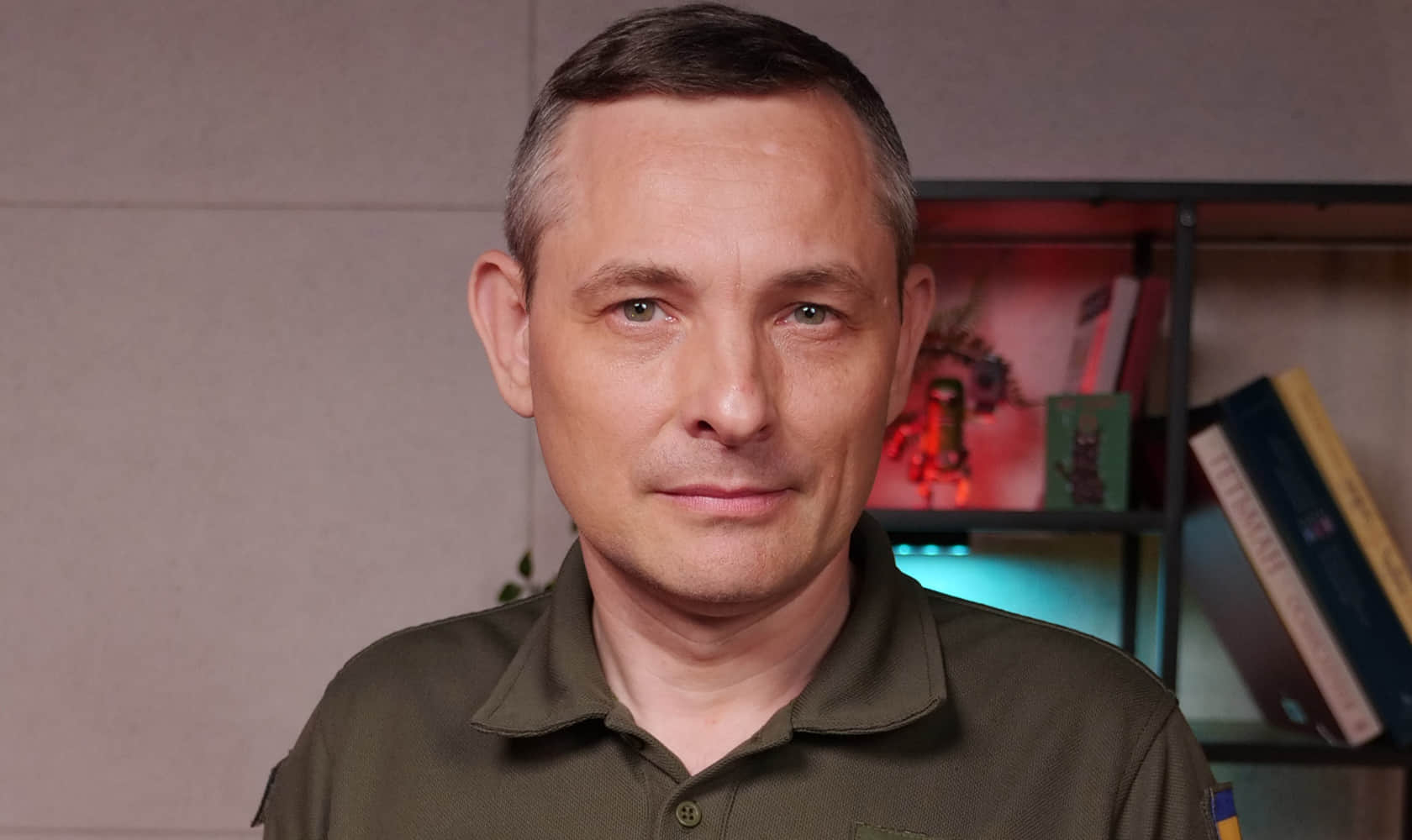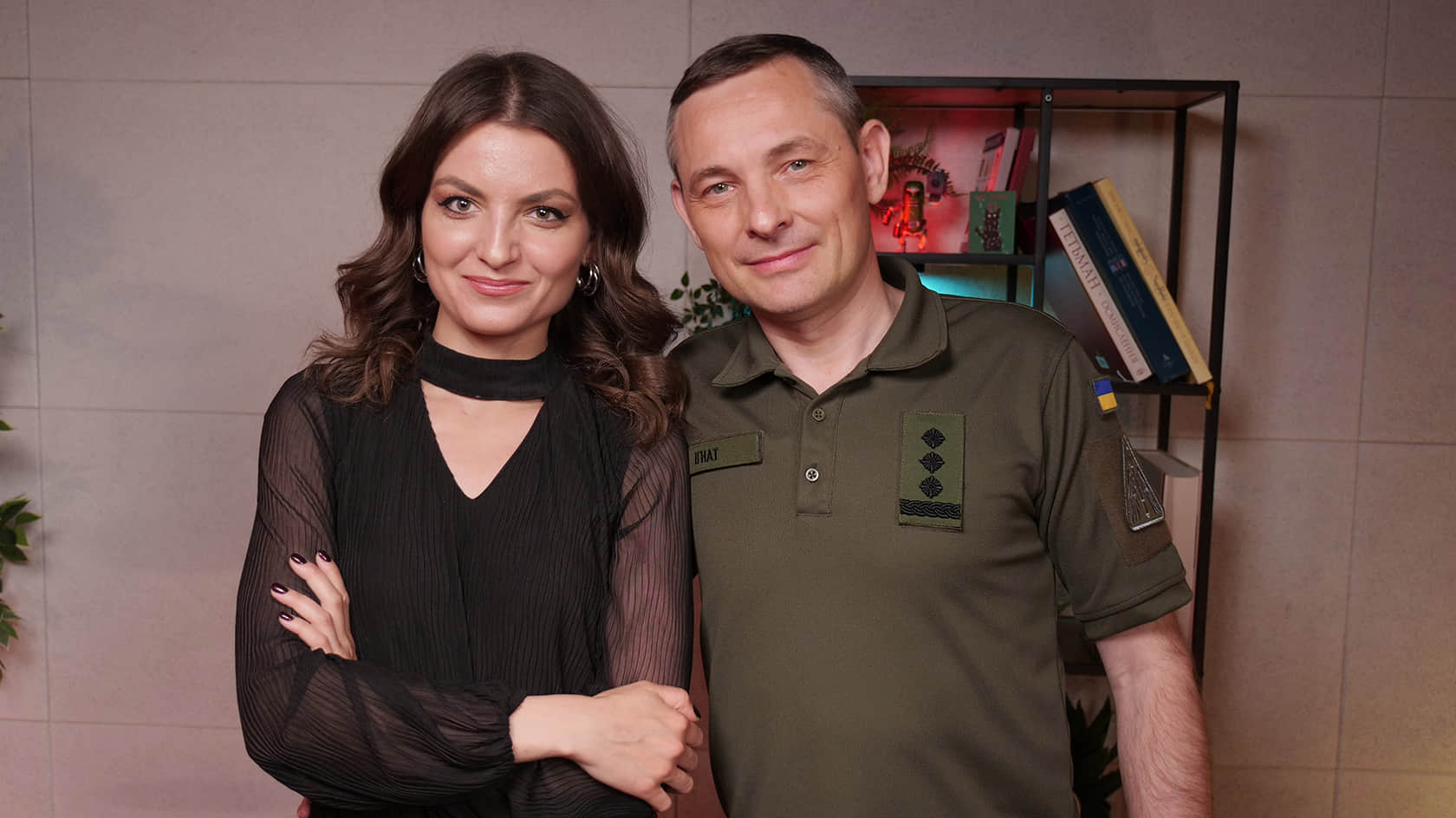Spokesman for Ukraine's Air Force: If we had surrendered the sky, the entire country would look like Mariupol or Bakhmut

How is it that Russia is able to continue launching missile strikes on Ukraine if it only had enough missiles for "2 or 3" large-scale attacks, as Ukrainian officials have said on many occasions? Yurii Ihnat, spokesman for Ukraine’s Air Force, believes that Western sanctions are not working, enabling Russia to build up its missile capabilities.
How quickly can Moscow manufacture new missiles, and how many will it be able to produce?
How is Russia trying to circumvent Ukraine’s air defence systems, and how effective are its own air defences?
Is it possible that Ukraine will run out of Patriot missiles because of numerous and extensive Russian missile and airstrikes?
How do anonymous Telegram channels find out about Russian attacks, and can they be trusted?
Ukrainska Pravda discusses these and many other questions with Yurii Ihnat.
Below is a condensed version of the interview. The full version is available here, in Ukrainian.
"If Russia controlled the sky, we probably wouldn’t have our country by now"
Representatives of Ukraine’s Defence Intelligence and National Security and Defence Council have said on many occasions that "Russia only has enough missiles for 2–3 large-scale attacks." But we continue to see more missile strikes. How is Russia able to continue attacking?
Because sanctions aren’t working. Unfortunately, Russia is able to obtain [missile] components. Unfortunately, it is able to continue manufacturing [missiles].
Russia didn’t have enough high-precision, long-range missiles – Kh-101, Iskander-M, Iskander-K, Kalibr, Kinzhal – missiles that can reach far into [Ukraine] and hit their targets with precision. They used up almost all of their stocks of these strategic weapons during their attacks on our critical infrastructure.
There was a short break this spring as [Russia] ramped up production. Now it has more Kinzhal and Kalibr missiles once again, according to Defence Intelligence data.
It’s clear that Russia has found ways to circumvent sanctions by relying on countries that continue to cooperate with it, and is receiving technical components that it can’t manufacture itself: boards, chips, semiconductors. All these elements make a missile work.
So I hope that sanctions will keep putting pressure on Russia. If sanctions are implemented systematically, and if they are enforced, then we will be able to put Russia in its place.
How fast can Russia manufacture missiles?
Even if they have all the necessary components, production takes time. The cruise missiles they use to attack us are like unmanned aircraft, and it takes quite a while to assemble them.
It takes quite a bit of time to assemble them, to test them, to deliver them to launch vehicles…
Comparing the attacks Russia was launching soon after 24 February and the most recent ones, what are some of the main differences between them, in terms of technology and in terms of strategy?
On 24 February, they started by targeting the Air Force. The Air Force was their number one target. Military airfields, aircraft, anti-aircraft missiles and radio engineering troops.
They wanted to blind us, to deprive us of means of repelling air and missile strikes. If Russia had managed to control the sky, we probably wouldn’t have our country by now. Because [controlling] the sky is key to the success of any ground operations. If we had surrendered the sky, the entire country would look like Mariupol or Bakhmut by now.
The Air Force was able to preserve its potential, and within a month or two we pushed all Russian aircraft out from the Ukrainian-controlled territory.
Russia ramped up its missile strikes in autumn [2022], though it’s been deploying missiles to attack Ukraine since the beginning of the war.

Many Ukrainian cities, especially in eastern and southern Ukraine, frequently suffer Russian missile strikes. Meanwhile, in Kyiv there was a certain lull. In May, however, hardly a day went by without air-raid warnings, without overnight attacks.
Why have missile strikes on Kyiv intensified?
Missile strikes on Kyiv never quite halted. Kyiv is at the heart of Ukraine. There are many strategic facilities that enemy forces are particularly interested in in Kyiv: government agencies, state institutions, the banking system, hydrotechnical facilities.
But why were there more attacks in May?
First of all, there is the propaganda issue, and it’s very important.
They’ve failed to reach their desired outcomes on the eastern front: they managed to destroy Bakhmut, but not capture it. They’ve suffered devastating losses in equipment and manpower.
Once they were no longer on the offensive, and started conducting defensive operations, they had to have something to show their own citizens. They need images of Kyiv on fire.
They are particularly interested in Patriots [US-made surface-to-air missile systems - ed.] which have been very effective since Ukraine obtained them. [Russia] needs to show the superiority of Russian weapons over American ones.
"Replacing Soviet air defence systems will take a long time"
Could these extensive missile strikes lead to Ukraine running out of Patriot missiles?
Fifty countries from across the world support us within the Ramstein format. These countries have stressed that they will support Ukraine for as long as needed.
So it’s unlikely that Ukraine will run out of Patriot missiles? Did I get that right?
I’ll tell you more: we would’ve run out of S-300 and Buk missiles a long time ago if not for our Western partners. Many countries across the world still have those old Soviet-made missile systems that Ukraine does.
The majority of our air defence equipment dates back to Soviet times. It’s unreasonable to think that if we got some weapons from the West, we now have it all. Replacing the Soviet systems will take a long time.
The whole world is helping Ukraine, and Patriot missiles are part of that. It’s not like they gave us Patriot [missile systems] and missiles once and that’s it. Aircraft, HIMARS rocket launchers – the West needs to constantly supply all these things. For our part, we are trying to use these weapons in an effective manner.
Patriots are unique because different types of missiles can be used in each system at once: some cheaper, some more expensive, some anti-aircraft missiles.
Is Russia trying to deceive Ukraine’s air defence system, for example by creating fake missile threats?
We try to deceive and mislead them too. And we’ve seen some successes.
Of course, the enemy forces are coming up with all sorts of things. They’re using Kh-101, Kh-555 and Kh-55 missiles designed to carry a nuclear load and carry out high-precision strikes, but instead of the nuclear load they use what we call imitators.
This is essentially a dummy missile, but we can’t know whether it’s a Kh-55, a Kh-555 or a Kh-101. For us it’s still an object on the radar, and we have to shoot all of those down.
When will Ukraine receive the F-16 [fighter jets]?
I want to say very soon, so that you’d leave me alone. [Ihnat smiles] But it’s probably not going to work like that.
We figured out that our pilots will need up to six months to learn to operate these jets.
Are they being trained now?
Not yet. The pilots are ready to go. The first group of our best pilots has been selected: they have combat experience and hundreds of hours of flying time, speak English, and are young. The list is being updated. Some of those pilots have been killed.
What you’ve got to know is that the cream of the crop will be trained first. We’re already waiting [for the training to start].
"Iranian-made drones are a headache"
In October 2022, you said that Ukraine was expending a lot of assets and personnel to shoot down Iranian-made drones. Is the situation different now, and is it easier to shoot them down?
Іranian-made drones are a headache. It’s still very difficult to down them.
When lots of them have been launched, they all fly along different routes, staying close to the ground, so that it’s difficult to shoot them from a plane. The drone’s speed is 150 km/hr, while a fighter jet flies at a minimum of 400 km/hr.
So it’s more difficult to shoot down drones than missiles?
You can’t shoot down a missile using small arms, and it’s virtually impossible to shoot down a missile using a machine gun.
Of course it’s more difficult to shoot down missiles. But it’s also difficult to detect drones, and we also have to use appropriate weapons to shoot them down.
And we can’t get those drones during the night using ground forces’ air defence equipment, mobile firing groups, or projectors, either.
Why is [Russia] launching drones at night? To deplete our air defence. To make us use our anti-aircraft missiles, so that they can see where our air defence systems are and target them during future strikes using aircraft or [naval-based missiles].
"Enemy forces are using Telegram posts to obtain a map of what’s going on in the sky"
One of Ukrainian air defence’s problems is the people who film it in action. Just recently several bloggers [who posted videos of Ukrainian air defence systems operating] have been served with notices of suspicion.
How is their case different from, for example, photographer Yevhen Maloletka [who won this year’s Pulitzer Prize - ed.] posting pictures of Ukraine’s air defence operating in his Instagram account?
Can these cases be compared?
Is it important to document air defence in action? It definitely is.
But posting [images or video] of air defence operating, especially in real time, is a threat.
A simple example: Kyiv, air defence is operating, people are taking photos from three different directions and posting them, or CCTV cameras are broadcasting it in real time. Meanwhile, enemy forces are watching the outcomes of their attack unfold live, like a movie, analysing what’s happening, and determining the coordinates where [Ukrainian] air defence systems might be based.

Taking pictures of missiles that have crashed is different. We have fragments of both their and our missiles crashing.
If our national newscast or some other media shows a missile fragment, and it’s a fragment of a Patriot missile, what does [Russia] do? [It says things like:] "Look at what the Ukrainian Nazis are using to attack the citizens of their own country." [Russia] uses this for its own propaganda purposes. So it’s better to refrain from this.
Don’t give enemy forces any additional information that they can use for their purposes. If they are able to determine the exact location of [Ukrainian] air defence systems, they might conduct another strike.
Continuing on the issue of social media, I wanted to ask you about Telegram channels. There are many anonymous Telegram channels that report [information about] Russian aircraft taking off, the load and missiles they carry, or whether they’re carrying any weapons.
How do these Telegram channels find out about these things? And can they be trusted?
It’s a difficult question. Where do they get this information from? It seems that someone is telling them these things. Who’s doing that? People with access.
Air Force personnel are the ones with access.
Not just the Air Force. All defence forces have access to this information. All defence forces are monitoring the situation in the sky, our systems quickly convey this information to different units; this information cascades all the way down to brigades and companies.
We have a Virazh Tablet system, which shows the situation in the sky. Heads of local Oblast Military Administrations also have access to this information. We don’t know who runs those Telegram channels and where they get their information from.
Right, you don’t know who runs them. But in general, is it okay for them to share this information? On the one hand, they warn people, but on the other, how can we know that this information is true?
Heads of Oblast State Administrations also share information [about incoming missile and airstrikes].
For example, we talked to Vitalii Kim [Head of the Mykolaiv Oblast Military Administration - ed.] about it: as the head of the oblast, he wants to be able to warn the oblast residents [about imminent attacks] so that they can get to shelter. Why not?
Okay. What about politicians doing this on their Telegram channels?
That’s on their conscience. Wanting to curry some political favour is one thing. Wanting to help people is completely different.
But should people trust this information or not?
If the Telegram channel is trustworthy and the information is confirmed each time, people can draw their own conclusions.
I once had a quarrel concerning Telegram channels. I asked law enforcement officials how we could avoid sensitive information from ending up [on Telegram], because all of these channels we’re talking about have shared the Virazh Tablet system which I was just talking about, showing radars, and the movement of UAVs and missiles across the territory of Ukraine.
They were reporting things like: "They entered X Oblast. They’re advancing. We see five of them. Be careful." Then five minutes later they’d post: "They disappeared in the vicinity of settlement Y. They are no longer seen." All this was accompanied by photos and screenshots. They revealed an area where we had nothing [i.e., no air defence equipment - ed.].
Enemy forces were then able to use these messages to obtain a map of our air defence: where we have air defence systems, where they’re operating, where we’re able or unable to detect their air targets. Do you realise how dangerous this is?
"The air defence systems our partners have given us are not sufficient"
Let’s talk about Russia’s air defence, how effective is it? How elaborate is it?
Russian air defence systems are being "upgraded" only if you believe information coming out of Moscow.
You see how elaborate it is when drones can reach as far as Rublyovka [a prestigious neighbourhood in Moscow - ed.] or even the Kremlin.
Putin’s bunker has a multi-level air defence system, I can guarantee that. Maybe similar systems are protecting Moscow and the line of contact. But it’s impossible to get air defence to cover all of Russia.
Does Ukraine have a "missile shield"? And when might it obtain a "missile spear"?
A "missile spear"? It’s unfortunate that we haven’t come up with it sooner. We used to parade Hrim-2 (Sapsan), and it’s exactly the "spear" that we could’ve used [to inflict damage on Russia]. It’s possible we wouldn’t even have had to really get it out and threaten to use it.
If Ukraine had had a sufficient number of Hrim-2 (Sapsan) operational-tactical missile systems, we’re not sure Russia would have dared to occupy Crimea and other territories.
[Hrim-2] operational-tactical missile systems have a range of 300-500 kilometres and would’ve been able to destroy Russian airfields and inflict devastating losses on Russian troops as they approached our borders.
It’s a huge disadvantage for Ukraine that unfortunately it hasn’t been able to manufacture a system like this since it’s become independent.

Given the current circumstances, when might Ukraine obtain a "missile spear"? Is it at all possible?
It’s quite difficult to achieve this now, with the war going on. But it’s possible with the support of our allies, who might be able to help develop a [weapon] system and set up its mass production – this would allow us to put [such a weapon system] into service. Why not? Some sort of joint production might be set up, like we’re trying to do with Bayraktar [unmanned combat aerial vehicles].
Do we have sufficient air defence capabilities to call them a "missile shield"?
If [we’re talking about] missiles that target facilities on the ground, then no; and they won’t be sufficient for a long time. Old Soviet systems still form the majority of our air defence.
Unfortunately, as of now, the systems that our partners have given us are extremely insufficient.
Sofiia Sereda, Ukrainska Pravda
Translated by Olya Loza
Edited by Dasha Narog, Teresa Pearce